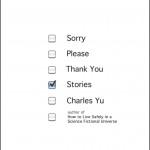20 Mar / Five More to Go: Readymade Bodhisattva, edited by Sunyoung Park and Sang Joon Park [in The Booklist Reader]

 Readymade Bodhisattva: The Kaya Anthology of South Korean Science Fiction, edited by Sunyoung Park and Sang Joon Park
Readymade Bodhisattva: The Kaya Anthology of South Korean Science Fiction, edited by Sunyoung Park and Sang Joon Park
Tenacious indie nonprofit Kaya Press launches its Magpie Series (which showcases Korean titles in translation that encapsulate “a reflexive picture of Korea and the breakneck speed of its changing interactions with the world”) with this collection of 13 diverse sf stories originally published between the 1960s and 2010s. Standout stories include the titular “Readymade Boddhisattva,” about an enlightened monastery robot; “Storm between My Teeth,” which features secret alien warriors living among humans (and eliminating one another); “Between Zero and One,” where family relationships are further complicated by time travel; and “Our Banished World,” in which teens deduce their universe is part of a fatal simulation.
Science fiction in Korea is relatively new. In the postwar decades, Korea’s political, socioeconomic, and technological reinvention created fertile conditions for a distinctly homegrown sf community of writers and readers. Editors Sunyoung Park and Sang Joon Park have recruited translators and academics to provide additional, insightful context for each story and author, giving readers a multilayered introduction – presented in a unique layout – to contemporary Korean science fiction.
Below you’ll find five intriguing titles filled with surreal, strange, and unexpected stories from other international writers with Asian roots.
 Look Who’s Morphing by Tom Cho
Look Who’s Morphing by Tom Cho
Cho is much-lauded and awarded in his native Australia, and his 18 sorta-interlinked stories here are sure to elicit gasps, guffaws, and more. In “Suitmation,” a different identity is available to anyone and everyone, from Godzilla to Olivia Newton-John. Meanwhile, the two siblings in “Dinner with My Brother” admit they might choose Marlon Brando and Indiana Jones over their own Chinese monikers. Inner rage goes out of control in “Today on Dr. Phil,” and the protagonist in “The Bodyguard” chivalrously deals with a bionic stalker to save Whitney Houston. While the stories unfold in surreal glimpses, a blurred outline of the unnamed narrator emerges: he is a Chinese Australian young man with extended relatives on multiple continents, including parents and a brother Hank, who has a sometime girlfriend Tara among many, many lovers. In his many morphing guises, Cho explores myriad unexpected identities and impossible situations.
 People Are Strange by Eric Gamalinda
People Are Strange by Eric Gamalinda
Writer/playwright/filmmaker/photographer Gamalinda’s collection comprises 16 years of short stories, the oldest of which is “Fear of Heights,” published in Harper’s Magazine circa 1995, a bittersweet tale about a fortune-teller who shares “a few trade secrets.” The most recent is the entertainingly ironic “Famous Literary Frauds,” which ran in a 2011 issue of the Asian American Literary Review and is about a Filipino writer who can only get published in the guise of his beautiful, young student – who then becomes a high-wattage literary celebrity. The rest of Gamalinda’s titular “strange” people include an adopted Marcos “son,” a dead man sending emails to his ex-wife, the Elvis of Manila, a fictional Eric Gamalinda who can change skin color at will, and a murderous fly-killer. Ultimately, the characters search for connection in a chaotic world, their strangeness makes them more uniquely human.
 Slightly Behind and to the Left: Four Stories & Three Drabbles by Claire Light
Slightly Behind and to the Left: Four Stories & Three Drabbles by Claire Light
Hyphen magazine cofounder Light’s slim, bright little book is not just sf, but rather feminist sf, Light’s genre of choice. The collection opens with a shocker titled “Vacation,” and a way-in-the-future Amazonia where all the adult men have disappeared. The spine-chilling “Pigs in Space” stars two workers who run an outer space pig farm. The final two interlinked stories include “Pinball Effect,” in which a single human is temporarily allowed to visit planet F&***rk where he loves and loses the elusive O#%M#T); and “Abducted by Aliens!” in which the story of that single human, now returned to Earth, is recalled through the lens of his sister’s memory decades later. In her afterword, Light admits “A childish part of me wants you to just get it,” as she explains the ultimate alien Asian American experience: Japanese American imprisonment during World War II. Indeed, while her readers might be “slightly behind,” Light is (I can’t resist) light years ahead in reinventing the Asian American experience, feminist sf–style.
 Sorry Please Thank You by Charles Yu
Sorry Please Thank You by Charles Yu
In Yu’s latest collection, 13 stories are divided into four categories: Sorry, Please, Thank You, and All of the Above. The commonplace nature of these words, however, stands in sharp contrast to the surreal tales they offer. In “Standard Loneliness Package,” a young man in Bangalore, India, works in a new sort of call center, where any and all unwanted emotions can be outsourced: “Don’t feel like having a bad day? Let someone else have it for you.” In “First Person Shooter,” a lovelorn young man working “the graveyard shift at WorldMart” helps a zombie “pull together a decent-looking outfit.” In “Hero Absorbs Major Damage,” a chicken-craving warrior and his quickly debilitating army might be at the mercy of a nine-year-old god “whose mom keeps yelling at him to clean up his room.” And in “Yeoman” (which surely is doing the wink, wink nod at Star Trek’s randy Captain Kirk), a man with an eight-months-pregnant wife faces death at the end of the week – because that’s just part of his job.
 Where Do We Go When All We Were Is Gone by Sequoia Nagamatsu
Where Do We Go When All We Were Is Gone by Sequoia Nagamatsu
Writing and literature professor Nagamatsu’s wacky and weird fiction debut defies easy categorization: let’s say it’s an amalgam of sf/fantasy, horror, and black comedy, overlaid with ancient-to-contemporary Japanese myth and culture. The 12-piece collection’s atypical characters include “Margaret Mead of the Kaiju [strange creatures] world,” who gets eaten by Godzilla; a husband with an infinitely stretchable neck who tracks his cheating wife; a couple who use yokai (supernatural monsters) to reanimate their dead daughter; Urashima Taro, a fisherman who rescued a turtle’s sons; and a dance-to-the-death-athon participant who headlines the title tale. To best enjoy these glimmers of ingenuity, originality, and even whimsy, a strong familiarity with Japanese pop culture is highly recommended.
